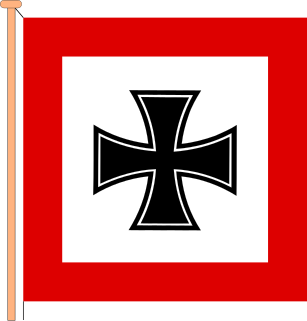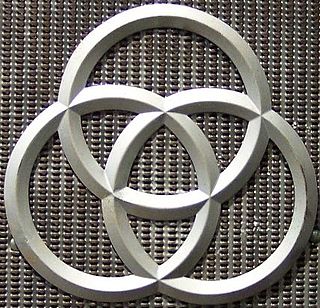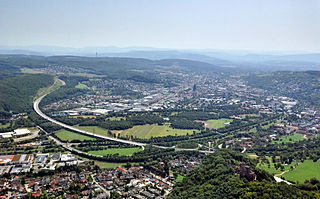
The 21 cm Mörser 18, or 21 cm Mörser M 18/L31, was a German heavy howitzer used in the Second World War by independent artillery battalions and batteries. A number were also used by coastal artillery units.
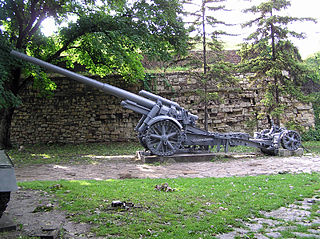
The 15 cm Kanone 18 was a German heavy gun used in the Second World War.

The 10 cm Kanone 17 was a field gun used by Germany in World War I and World War II.

The 10.5 cm schwere Kanone 18 was a field gun used by Germany in World War II. The German army wanted a new 10.5 cm gun as well as 15 cm howitzer which were to share the same carriage. Guns are heavier than howitzers due to the longer barrel. This also led to the 15 cm sFH 18. As such both weapons had a similar weight and could be carried by a similar carriage. By 1926 Krupp and Rheinmetall had specimen designs, and prototypes were ready by 1930, but was not fielded until 1933–34. Both Krupp and Rheinmetall competed for the development contract, but the Wehrmacht compromised and selected Krupp's carriage to be mated with Rheinmetall's gun.
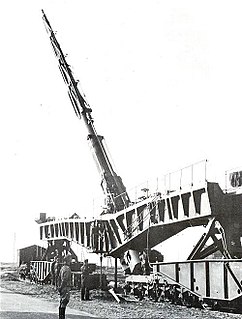
The 21 cm Kanone 12 in Eisenbahnlafette was a large German railroad gun used in the Second World War and deployed on the English Channel coast in occupied France.
The 17 cm Kanone in Eisenbahnlafette was a German railroad gun used in the Second World War.
The 15 cm Kanone in Eisenbahnlafette was a type of German railroad gun used in the Second World War. They were used in the invasion of Belgium in 1940, but spent most of the war on coast-defense duties.

The 15 cm Kanone 16 was a heavy field gun used by Germany in World War I and World War II. Guns turned over to Belgium as reparations after World War I were taken into Wehrmacht service after the conquest of Belgium as the 15 cm K 429(b). It generally served on coast-defense duties during World War II.
The 15 cm Kanone 39 was a German heavy gun used in the Second World War. First deliveries began in 1940 to the Wehrmacht. In the Battle of France, only the independent Artillerie-Batterie 698 was equipped with the gun. For Operation Barbarossa, it served with the Artillerie-Abteilungen 680, 731, 740 and 800. A year later, for Fall Blau, they served with Artillerie-Abteilungen 511, 620, 680, 767 and 800.
The 21 cm Kanone 38 was a heavy gun used by Germany in World War II. Its development began in 1938 after Krupp's success with the 21 cm Mrs 18, but it was not fielded until 1941. It likely equipped Artillerie-Abteilungen 767 and 768, which were the only Heer battalions to field 21 cm guns during the war. Some guns may have served on coastal defence duties.
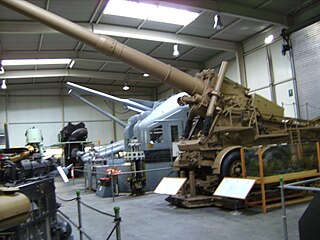
The 24 cm Kanone 3 was a German heavy siege gun used in the Second World War by the first battalion of Artillerie-Regiment 84. Four were in service when Germany invaded Poland, assigned to the first two batteries of I./AR 84. In the Battle of France the battalion still only had four guns. By Operation Barbarossa all three batteries were equipped with two guns apiece. This situation did not change for the next two years.

The 24 cm SK L/40 "Theodor Karl" was a German railroad gun that served on both the Eastern Front and the Western Front in World War I. Originally a naval gun, it was adapted for land service after its ships were disarmed beginning in 1915. One gun saw service in the Belgian Army after the war. After Belgium's surrender in World War II, the Germans used that gun on coast-defense duties for the rest of the war.

The 24 cm Theodor Kanone was a German railroad gun used during World War II in the Battle of France and on coast-defense duties in Occupied France for the rest of the war. Three were built during the Thirties using forty-year-old ex-naval guns.

The 24 cm Theodor Bruno Kanone was a German railroad gun used during World War II in the Battle of France and on coast-defense duties in Occupied France for the rest of the war. Six were built during the Thirties using fifty-year-old ex-naval guns.
The 20.3 cm Kanone was a German railroad gun used on coast-defense duties in Occupied France and Belgium during World War II. Eight guns were transferred from the Navy's stocks after having become redundant with the loss and sale of several Admiral Hipper-class heavy cruisers and were delivered in 1941 and 1942.

The 38 cm Siegfried K (E) was a German World War II railway gun based on the 38 cm SK C/34 naval gun that served as the main armament of the Bismarck-class battleships. Only four were produced.

The 21 cm Kanone 39 was a Czech-designed heavy gun used by the Germans in the Second World War. Two were built before the Germans occupied Czechoslovakia in March 1939 and seized the rest of the guns and kept it in production for their own use, eventually building a total of 60 guns for themselves. They saw action in Operation Barbarossa, the Siege of Odessa, Siege of Leningrad and the Siege of Sevastopol and were used on coast defence duties.
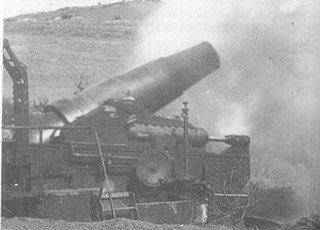
The 28 cm Haubitze L/12 was a German coastal defense and siege howitzer. Developed by Krupp before World War I that saw service in both World War I and World War II.
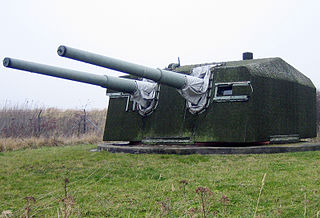
The 15 cm SK C/28 was a German medium-caliber naval gun used during the Second World War. It served as the secondary armament for the Bismarck class and Scharnhorst-class battleships, Deutschland-class cruisers and the Graf Zeppelin-class aircraft carriers. A number of surplus weapons were used as coast-defense guns and eight were adapted to use Army carriages and used as heavy field guns as the 15 cm Schiffskanone C/28 in Mörserlafette

The 28 cm SK L/40 was a German naval gun that was used in World War I and World War II as the main armament of the Braunschweig- and Deutschland-class pre-dreadnoughts.


